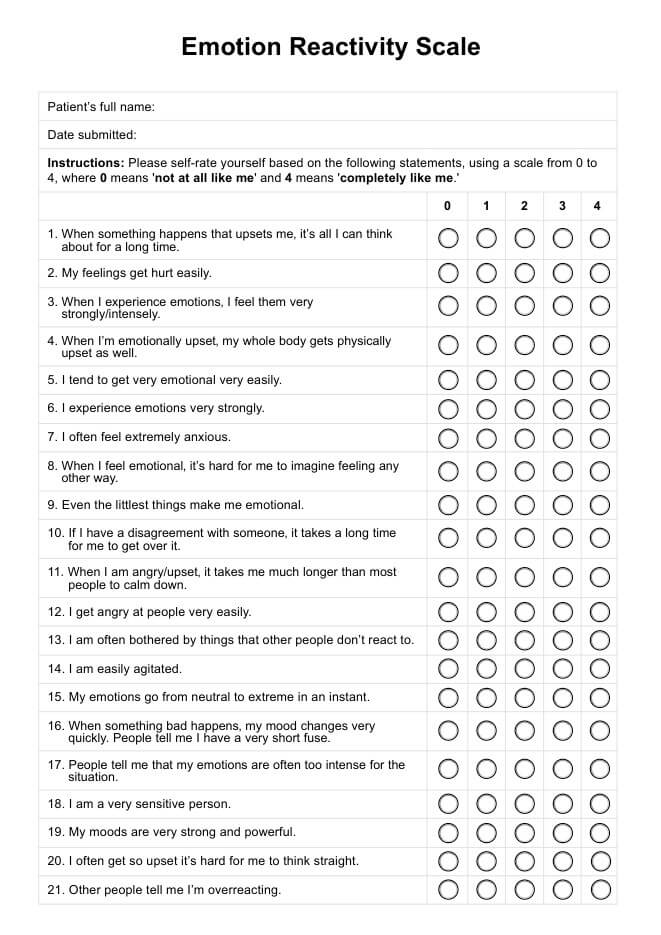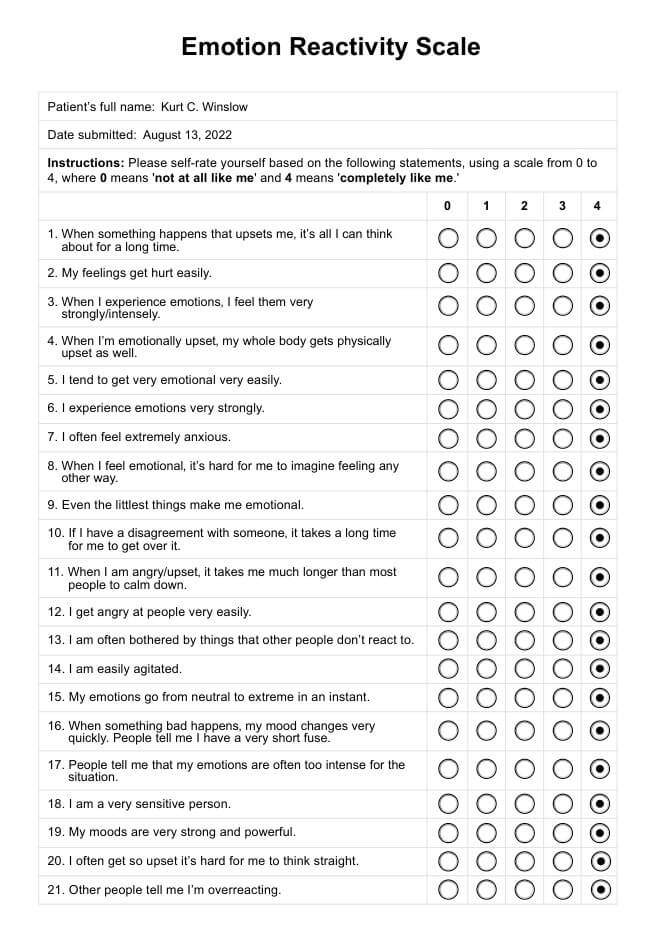Emotion Reactivity Scale (ERS)
Use our Emotion Reactivity Scale template to assess a patient's degree of emotional reactivity based on their self-ratings.


What is the Emotion Reactivity Scale?
The Emotion Reactivity Scale (ERS) was developed by Matthew K. Nock‚ Michelle M. Wedig‚ Elizabeth B. Holmberg‚ and Jill M. Hooley back in 2008, published in their paper entitled “The Emotion Reactivity Scale: development‚ evaluation‚ and relation to self-injurious thoughts and behaviors.” It was developed to assess a person's emotional reactivity, which is how strongly they experience certain negative emotions and, by extension, how it puts them at risk of having self-injurious thoughts and enacting self-injurious behaviors.
During its development, the authors used exploratory factor analysis to determine the tool's factor structure, which revealed three factors of emotion reactivity: emotion sensitivity, emotional arousal/intensity, and emotion persistence. The scale has a strong internal consistency, with a Cronbach's alpha of 0.94 for the total ERS score. (Nock et al., 2008)
How is this scale answered?
The Emotion Reactivity Scale is a 21-item list of statements all related to a person's emotional responses. Examples of such statements include the following:
- When something happens that upsets me‚ it’s all I can think about for a long time.
- When I’m emotionally upset‚ my whole body gets physically upset as well.
- Even the littlest things make me emotional.
- When I am angry/upset‚ it takes me much longer than most people to calm down.
- I am easily agitated.
- When something bad happens‚ my mood changes very quickly. People tell me I have a very short fuse.
To answer each item, the respondent only needs to pick a number from 0 to 4. 0 means "not at all like me." 4 means "completely like me."
How is it scored?
After the respondent returns a fully answered Emotion Reactivity Scale, all you need to do is to calculate the sum of all scores and write the totals for the following:
- Sensitivity subscale score (items 2‚ 5‚ 7‚ 9‚ 12‚ 13‚ 14‚ 15‚ 16‚ and 18)
- Arousal/intensity subscale score (items 3‚ 4‚ 6‚ 17‚ 19‚ 20‚ and 21)
- Persistence subscale score (items 1‚ 8‚ 10‚ and 11)
- Total score (all items)
There are no set score ranges for this, but the rule of thumb is the higher the total score, the higher a person's emotion reactivity.
Emotion Reactivity Scale (ERS) Template
Emotion Reactivity Scale (ERS) Sample
How to use our Emotion Reactivity Scale template
We'd like you to know that we created a template for the Emotion Reactivity Scale that you can use when assessing people for clinical psychology purposes or therapy programs.
Our template takes the 21-item list. Beside each item, there are 5 set answer choices: 0 to 4. Each answer choice has radio buttons for you to tick with a pen (if you decide to use printed versions for your work) or with a click or tap (if you sent respondents digital copies).
There are editable fields for indicating the respondent/patient's full name, the date they answered and submitted the scale, and for indicating your full name (you being the psychologist or therapist handling the patient/respondent). Some of these editable fields are for writing down the scores for each subscale and the total score.
That's it!
Clinical application of the Emotion Reactivity Scale
If you're a clinical psychologist or therapist dealing with a patient who has intense emotional responses due to heightened emotional sensitivity or because of a specific mental health issue, issuing this is a great way to gauge how strong their emotional reactivity is.
If a patient gets a high score, their emotional reactivity is high. But that's not exactly enough to gauge a patient fully, right? This scale should be used alongside other assessments, such as an emotion regulation scale like the DERS Scale and tools that can be used in the diagnostic process for affective disorders.
Since this was made by experts who believe there is a link between heightened emotional reactivity and self-injurious thoughts and behaviors, it would be best to conduct comprehensive examinations of a patient to determine if specific mental health issues are contributing to their emotional reactivity and if they also influence possible tendencies to have self-injurious thoughts and behaviors. Doing so could help them get to the root of the problem.
Once the root of the problem has been determined, you can develop a treatment plan that takes into account their heightened emotional reactivity and whatever mental health problems they're confirmed to have. Cognitive behavioral therapy can help them reconfigure how they examine their emotions, and dialectical behavior therapy can help teach them emotion regulation.
Reference
Nock, M. K., Wedig, M. M., Holmberg, E. B., & Hooley, J. M. (2008). The Emotion Reactivity Scale: development, evaluation, and relation to self-injurious thoughts and behaviors. Behavior Therapy, 39(2), 107–116. https://doi.org/10.1016/j.beth.2007.05.005
Commonly asked questions
No. It's only meant to assess how heightened a person's emotional reactivity is based on their self-ratings. It can help with the diagnostic process for a mental health disorder, but it shouldn't be the sole assessment.
You can during the treatment process to check progress on emotion dysregulation and see if their emotion reactivity levels are high or have gotten lower over time.
High emotional reactivity can be influenced by genetics, brain chemistry, mental health conditions, trauma, life experiences, and socialization, which includes gender differences. These factors interplay to shape how individuals respond emotionally to various situations.





















-template.jpg)


















































































